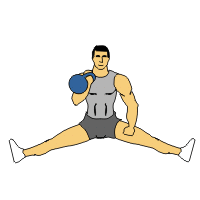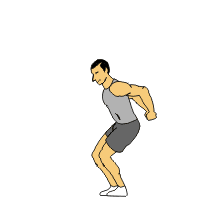Don’t Leave Your Game in the Weight Room!
- Roberto Parker

- Jul 22, 2018
- 6 min read
Updated: Jul 22, 2018
by Roberto Parker, MS, CSCS, MTA, FDN, FMS,USWA, CHEK2
There are four areas of physical training that I have termed The Four Components of Athletic Performance. Ever sport or recreational activity involves a combination, small, or large component of the following areas:
Balance / equilibrium
Mobility/flexiblity
Coordination/timing
Strength/power
I could add nutrition to the aforementioned list, however that is an entirely different conversation that would be very lengthy. The bulk of this article will center around strength performance and the proper application of strength performance.
Since my Strength and Conditioning Coaching career began in 1982 , I’ve always had the saying “Do not leave you game in weight room”. Just because you can lift a building does not mean it transcends to performance in your respective sport.
In other words, don’t be out of all balance with your strength training. In fact don’t out of balance in any area of conditioning and strength. To often in High School and to some extent College conditioning programs will have each individual athlete performing the same strength workout which normally consists of Big Four Lifts… bench press, squats, power cleans, and push press.
Normally the law the average will work to where 1/3 of those athletes are benefiting, 1/3 are maintaining, and the final 1/3 of those athletes could be regressing of increasing the risk of injury to overtraining. That averages out to only 1/3 of that particular team that is truly benefiting from the Big Four Lifts.
In working with competitive and/or recreational athletes it is our job as coaches and trainers to functionally develop athletes in all areas which will lead to better athletic performance and most importantly a physically healthy lifestyle they can adapt for the rest of their lives.
Take a look at these various scenarios that many coaches and trainers are faced with:
Athlete A” is an 8th grade 13 year old male Middle School Football and Wrestler who is pre-pubescent. He is extremely flexible( hyper mobile) and below average strength for his age bracket.
Athlete B” is a 18 year old 6’8”College male Basketball Player who is a great ball handler, however he lacks hip mobility, balance, and leg strength. In addition, barbell back squats irritates his back and knee areas
Athlete C” is a 16 High School Track and Football Athlete is extremely fast in the 100 meters but struggles with lateral speed and foot quickness. He also needs to add 15 pounds of solid muscle to compete for the starting running back position for the upcoming football season.
Athlete D” is a 15 year old female High School Volleyball player and is very athletically gifted, however her body weight and body fat is elevated which inhibits her play in latter rounds of weekend tournament games .
Each one of these scenarios requires a customized approach relative to a designed program which will enhance the athletic performance of each individual athlete.
I will never forget what Paul Chek once said “exercise is like drug….if you prescribe the wrong exercise you will get the wrong result”.
How do we approach and help these athletes maximize their potential?
Athlete “A” is a very young kid with little or no workout training experience. He is physically weak and has not reached puberty at age 13. Much bodyweight training is highly recommended:
Body weighted 1 legged squats
Pushups on floor or suspension trainer
Stability ball multi-plane core work
Medicine ball multi-plane core work
Assisted pull-ups and chinups
Weighted squats and lunges with medicine ball, light dumbbells, or kettlebells
Power band training with Kinetic Bands, Strength Bands, and bungee cords.
Since this young man is very flexible and hyper mobile I would avoid extreme stretching exercises or yoga exercises. Place a major emphasis on technique and body mechanics.
Going for maximum weight is ill-advised!
Athlete “B” is lacking mobility, strength, and balance in the hip and leg areas.
Program Recommendations:
Dynamic hip exercises that will stretch and strengthen the deeper hip muscles that are not activated with traditional squats.
Multiple sets of 1 legged squats( also using balance boards)
Because he is a taller athlete with longer legs and torso… traditional squats are placing negative compressive forces on his spine and knee areas. To correct this lets incorporate 1/2 squats, dumbbell lunges, and/or diamond bar deadlifts.
5-10 minutes of quality stretching concluding each training session and before bedtime.
Power band training with Kinetic Bands, Strength Bands, and bungee cords.
Athlete “C” is very fast in linear plane but needs to improve laterally with directional change. The human body is 3 dimensional design that must stimulated in a linear plane, rotational plane, and lateral plane. This young man is very strong and fast in 1 dimension but lacks in the other 2.
Program Recommendations:
Dynamic mobility and strength drills that emphasize rotation and lateral moving in space
Obstacle course training that emphasizes quick bursts of speed and quickness
Lateral lunges with a weighted object
incorporate boxing drills to enhance his foot work and hand speed
Emphasize static stretching after a training session
High Volume strength training sets to add mass and bulk.
2-3 minute rest intervals in between strength sets
Power band training with Kinetic Bands, Strength Bands, and bungee cords.
Athlete “D” is a young lady with great athleticism but she is slightly overweight with elevated body fat.
Program Recommendations:
diagnostic evaluation of her nutritional habits along with establishing dietary protocols.
incorporate strength training circuit with multiple stations that include compound strength drills, bursts of speed, agility, jump drills, and wind sprints.
emphasize short rest intervals of in between circuit stations( 1 minute or less)
change her routine every 2 weeks
Power band training with Kinetic Bands, Strength Bands, and bungee cords.
For those of you that are coaches in charge of monitoring your school strength facility and are assigned to training young men and women…. you are probably asking “how can I customize 100 individual workouts for 100 athletes in my program”?
The answer is… you can’t! They chore would be very unmanageable.
I was a Collegiate and NFL Strength and Conditioning coach for a combined 18 years. There were times I would have 3 groups of 30-40 athletes in a 4000 square foot facility with 60 minutes to train them. Not an easy task with 30-40 different personalities and motivational levels to deal with.
Here is my recommendation, you can have 4 basic training regimens that will meet the fundamental needs of practically every competitive athlete that steps into your strength complex and it’s very manageable.
The following list is what I call the Fundamental Four that meets the demands of the 4 Components of Athletic Performance:
Mobility/Strength-emphasis on improving stretching and movement skills in space while maintaining or increasing basic strength
Timing-Speed/Strength-emphasis on improving foot speed, agility, hand speed, being light on your feet, balance, and maintaining or increasing basic strength
Body Toning/Strength-emphasis on weight/fat loss, increasing muscularity, and maintaining or improving basic strength
Mass Gain/Strength- emphasis on gaining mass/strength, gaining weight, and maintenance of core functional strength.
Notice the common denominator with all 4 training regimens is strength, however, the numerator changes with each category . These regimens are not set in stone, they can be tweaked or mixed/matched in various ways to meet the individual needs of the athlete. In other words as a coach or trainer you will have 4 different template workout plans that are assigned to 4 different groups of athletes. New and various exercises and drills can be added or subtracted to the template at any time to meet the changing physical demands of the individual athlete.
In conclusion:
The goal of any athletic conditioning, speed, strength program is to advance the play on the field, court, mat, boxing ring…. It is great to have a high powered strength program and a kick ass weight room with all the bells and whistles, but is the objective to fully develop young athletes or build competitive weightlifters or bodybuilders?
Please do not misunderstand me, I not saying eliminate weight lifting drills from your program. What I am saying is that every athlete that walks into your facility has a different set of needs and priorities relative to the 4 Components of Athletic Performance.
The operative phrase is “customized balance” with each athlete. You don’t need to write out 50 different training workouts. The Fundamental Four is good launching point to help your kids break through the plateaus and set backs that may occur due to overtraining or boredom from doing the same weekly routine.
I implore all coaches, trainers, and/or parents who training young athletes to place an emphasis on training smart and hard (emphasis on smart)!
Programming a 12 month training regimen and incorporating corrective exercise is a definite science in which I would highly recommend seeking a certified strength and conditioning specialist.
Innovative Sports Training offers:
Program design and physical assessment
Team and Individual Training sessions
Nutritional Diagnostic evaluation
Workshops and seminars
Consultation for coaches and trainers
Contact information:
Rwpsports@yahoo.com
Phone: 816-405-7703






Comments